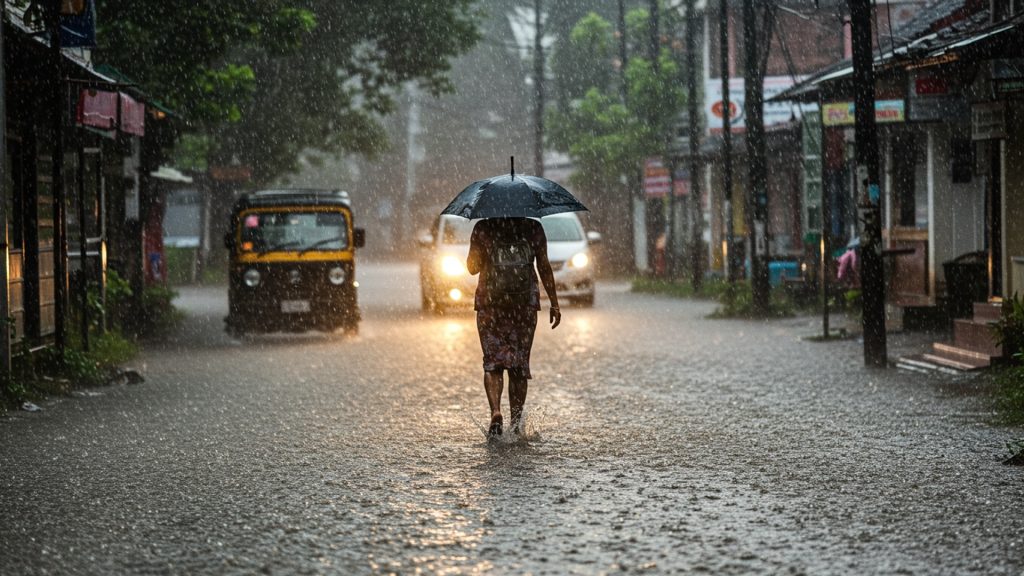Kerala is bracing for an intensified monsoon, with weather officials issuing a Yellow Alert for several districts as heavy rains lash the state. Communities are preparing for significant downpours, which could lead to flooding and disrupt daily life across affected areas. The India Meteorological Department warns that the heavy rain spell is set to worsen, requiring residents to stay vigilant as water levels are expected to rise rapidly.
Heavy Rain Warning for Districts
The India Meteorological Department (IMD) has stated that several districts across Kerala are likely to experience heavy rainfall as the monsoon grows stronger. A yellow alert has been put in place for many areas, warning people to be careful. This alert means that some places could get a lot of rain in a short time. On Saturday, August 16, Kozhikode, Kasaragod. Kannur districts are under a yellow alert. Earlier in the week, other districts like Pathanamthitta, Alappuzha, Kottayam, Idukki, Ernakulam, Thrissur, Malappuram. Wayanad also saw yellow alerts due to heavy rain. Weather experts predict that heavy rain, meaning 7 to 11 centimeters of rain in 24 hours, is very likely to happen in one or two places in Kerala from August 15 to August 18. There is a chance that in some areas, the rain might become very heavy, with 12 to 20 centimeters of rain, or even extremely heavy, which is more than 20 centimeters.
Understanding the Yellow Alert
A yellow alert is a warning from the weather department that means people should be aware and stay updated about the weather. It shows that there is a possibility of heavy rain, which could cause problems. The weather department issues these alerts to help people prepare for bad weather and avoid danger. This is part of a system that includes green (no warning), yellow (be aware), orange (be prepared). red (take action) alerts, based on the expected rainfall intensity.
Winds and Coastal Conditions
Along with the heavy rain, strong winds are also expected to affect Kerala. The IMD has warned that squally weather, with wind speeds of 40 to 50 kilometers per hour. gusts reaching 60 kilometers per hour, is likely to happen along and near the Kerala coast until Saturday. Strong surface winds, moving at 40 to 50 kilometers per hour, may also happen sometimes over Kerala and Lakshadweep from August 15 to August 17. Fishermen have been strongly advised not to go into the sea during this time because of the rough weather and high wind speeds. This warning is vital for the safety of those who work in the coastal areas.
Possible Problems from Rain
The continuing heavy rainfall and strong winds can lead to several problems across the state. These problems include poor visibility on roads, which can cause traffic jams and make travel difficult. There is a risk of trees falling or tree branches breaking, which can block roads and damage power lines, leading to electricity cuts. Homes made with weak materials, like huts, might also get damaged. In low-lying areas and cities, waterlogging is a big concern. This happens when roads and other areas fill up with water, making it hard to move around. There is also a higher chance of flash floods and landslides, especially in hilly regions that are already known to have such issues. Farmers might see their crops get damaged, especially those that are ready for harvest or have just been planted. The intense rain can also lead to mudslides in highland areas.
Safety Advice for People
Authorities have given clear advice to the public to ensure their safety during this period of heavy rain. People should stay alert and regularly check weather updates and alerts from the local weather department. It is vital to avoid areas that are known to flood. If thunderstorms occur, people should stay indoors and disconnect electrical appliances from power sockets to avoid damage. It is also advised to avoid standing near windows and doors during strong winds and lightning. Using a mobile phone is generally safe during a thunderstorm. using a landline phone should be avoided. For farmers, it is suggested to delay planting new crops and to use methods that protect the soil and roots of existing crops. Ensuring good drainage in fields is also essential. Overall, people are encouraged to strictly follow all safety advisories given by local authorities. Having an emergency kit ready with basic things like water, food, first-aid. crucial documents is also a good step.
Government Actions and Plans
The Kerala government and local bodies have been taking steps to prepare for the monsoon season. Funds have been given to districts and local self-government bodies to help them get ready and respond to any problems caused by heavy rain and floods. For example, 1 crore rupees has been given to each District Collector from the State Disaster Response Fund (SDRF) for urgent preparations or immediate relief. Some cities like Thiruvananthapuram and Kozhikode received extra funds for flood prevention because they are more likely to be affected. Meetings have been held at different levels, from the state to the district, to plan and review work related to monsoon preparedness. These plans include updating lists of people living in areas prone to disasters and landslides. collecting their mobile numbers to send timely alerts. Training programs are also being held. volunteer groups are being formed to help during emergencies. Special plans are also made for tribal areas to keep them safe. Local bodies are working to clean canals and drains, especially in areas that often face waterlogging. These efforts aim to make sure that the state can manage the monsoon effectively.
Community Efforts and Lessons
Past monsoon seasons, such as the severe floods in 2018 and 2020, have taught crucial lessons about preparing for heavy rains. These past events caused a lot of damage, loss of lives. affected many people. Studies have shown that extreme rain events have become more common and intense, partly due to changes in climate. For example, the rainfall that hit northern Kerala on July 30, 2024, was one of the heaviest recorded. Experts say that the way rainfall happens has changed, with long dry spells followed by short periods of very heavy rain. In response, communities and government bodies are working together. There are efforts to restore wetlands and add surfaces that allow water to soak into the ground, especially in urban areas. Children in Kerala are even part of volunteer groups that help keep track of rainfall and river levels. While a national early warning system for landslides is being planned, local efforts are already helping. Staying informed and taking local advice is crucial for residents to navigate the monsoon season safely.

